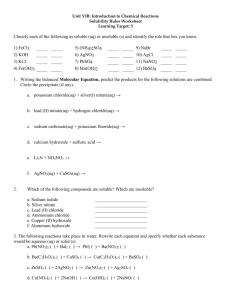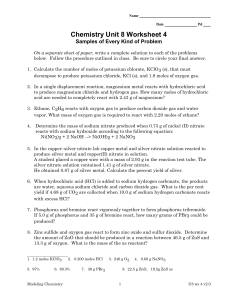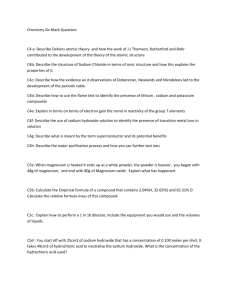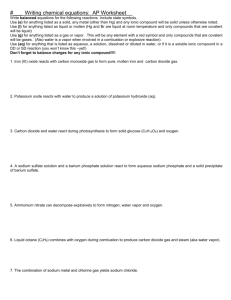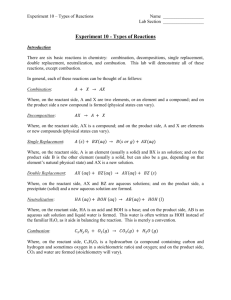AP Chemistry Review Week #1 Name: SHOW ALL WORK! Write
advertisement
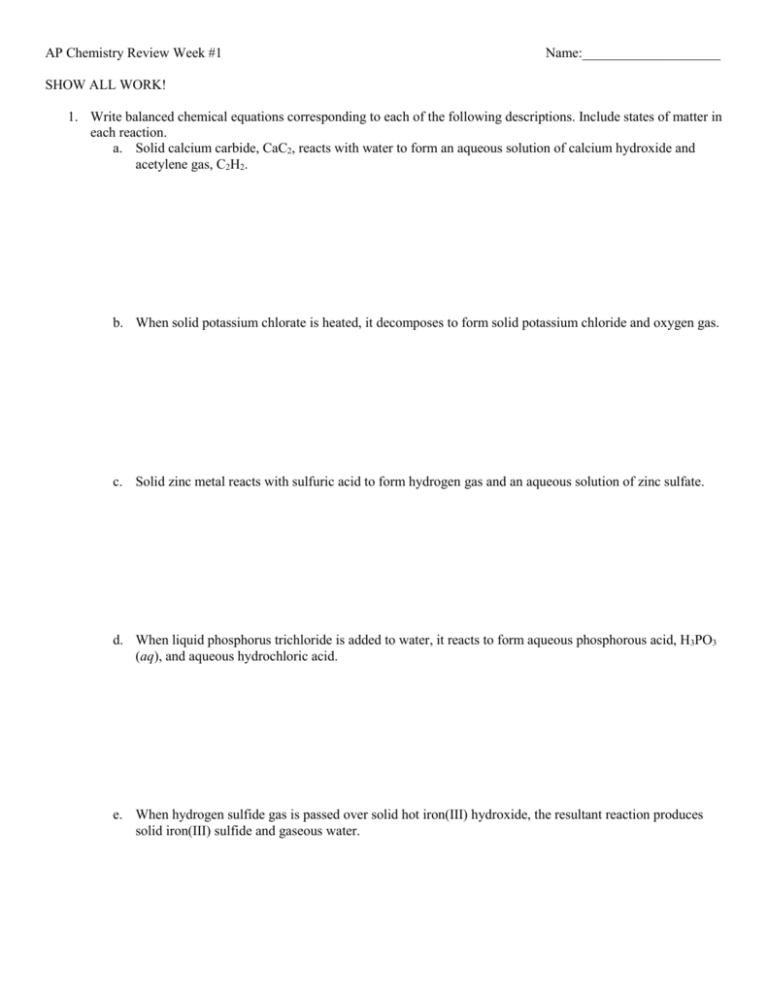
AP Chemistry Review Week #1 Name:____________________ SHOW ALL WORK! 1. Write balanced chemical equations corresponding to each of the following descriptions. Include states of matter in each reaction. a. Solid calcium carbide, CaC2, reacts with water to form an aqueous solution of calcium hydroxide and acetylene gas, C2H2. b. When solid potassium chlorate is heated, it decomposes to form solid potassium chloride and oxygen gas. c. Solid zinc metal reacts with sulfuric acid to form hydrogen gas and an aqueous solution of zinc sulfate. d. When liquid phosphorus trichloride is added to water, it reacts to form aqueous phosphorous acid, H3PO3 (aq), and aqueous hydrochloric acid. e. When hydrogen sulfide gas is passed over solid hot iron(III) hydroxide, the resultant reaction produces solid iron(III) sulfide and gaseous water. 2. Write balanced chemical reactions for each of the following reactions. Include states of matter in each reaction. a. Solid sodium combines with liquid bromine. b. Solid lithium combines with the nitrogen gas. c. Solid iron(III) hydroxide reacts with a solution of sulfuric acid. d. Solid zinc hydroxide reacts with a nitric acid solution. e. Solid magnesium metal reacts with chlorine gas. 3. Calculate the percentage by mass of the indicated element in the following compounds: a. Carbon in acetylene, C2H2 b. Hydrogen in ascorbic acid, HC6H7O6 c. Hydrogen in ammonium sulfate d. Platinum in PtCl2(NH3) 2 4. A sample of testosterone, C19H28O2, contains 3.88 × 1021 hydrogen atoms. a. How many atoms of carbon does it contain? b. How many molecules of the testosterone does it contain? c. How many moles of testosterone does it contain? d. What is the mass of this sample, in grams? 5. Determine the empirical formulas of the compounds with the following compositions by mass: a. 10.4% C, 27.8% S, and 61.7% Cl b. 21.7% C, 9.6% O, and 68.7% F c. 32.79% Na, 13.02% Al, and the remainder F d. 55.3% K, 14.6% P, and 30.1% O 6. Determine the empirical and molecular formulas of each of the following substances: a. Ibuprofen contains 75.69% C, 8.80% H, and 15.51% O by mass, and has a molar mass of 206 g/mol. b. Cadaverine, contains 58.55% C, 13.81% H, and 27.4% N by mass; its molar mass is 102.0 g/mol. c. Epinephrine contains 59.0% C, 7.1% H, 26.3% Co, and 7.7% N by mass; its molecular weight is about 180 amu. 7. The characteristic odor of pineapple is due to ethyl butyrate, a compound containing carbon, hydrogen, and oxygen. Combustion of 2.78 mg of ethyl butyrate produces 6.32 mg of CO2 and 2.58 mg of H2O. What is the empirical formula of the compound? 8. Nicotine is composed of C, H, and N. A 5.250-mg sample of nicotine was combusted, producing 14.242 mg of CO2 and 4.083 mg of H2O. What is the empirical formula for nicotine? If nicotine has a molar mass of 160 ± 5 g/mol, what is its molecular formula? 9. Detonation of nitroglycerin proceeds as follows: 4 C3H5N3O9(l) 12 CO2(g) + 6 N2(g) + O2(g) + 10 H2O(g) a. If a sample containing 2.00 mL of nitroglycerin (density 1.592 g/mol) is detonated, how many total moles of gas are produced? b. If each mole of gas occupies 55 L under the conditions of the explosion, how many liters of gas are produced? c. How many grams of N2 are produced in the detonation? 10. Solutions of sodium carbonate and silver nitrate react to form solid silver carbonate and a solution of sodium nitrate. A solution containing 3.50 g of sodium carbonate is mixed with one containing 5.00 g of silver nitrate. How many grams of sodium carbonate, silver nitrate, silver carbonate, and sodium nitrate are present after the reaction is complete? 11. You are given a cube of silver metal that measures 1.000 cm on each edge. The density of silver is 10.5 g/cm3. a. How many atoms are in this cube? b. Because atoms are spherical, they cannot occupy all of the space of the cube. The silver atoms pack in the solid in such a way that 74% of the volume of the solid is actually filled with the silver atoms. Calculate the volume of a single silver atom. c. Using the volume of a silver atom and the formula for the volume of a sphere, calculate the radius in angstroms of a silver atom. (1 angstrom = 1 × 10−10 meter)
